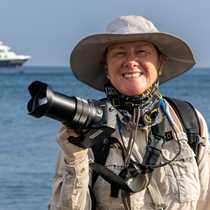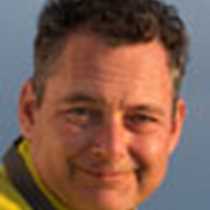A smooth overnight journey brought National Geographic Islander to the eastern coast of Santiago Island, where we anchored next to an island that, in silhouette, looks just like a traditional Chinese hat—and is called “Sombrero Chino” of course.
The morning proved to be overcast, even slightly misty, but with very comfortable temperatures. We departed by Zodiac right after breakfast in search of the Galapagos penguins. These sea birds are not numerous, and their population status is quite delicate. Variable climatic conditions can cause them to have either good, or bad, reproductive success. We were lucky to have one little individual leave the water just as we drove by. She/he stood upright, as penguins do, and groomed itself thoroughly before once more popping back into the ocean. Nearby were two blue-footed boobies and a brown pelican. It seemed we had it all for a few moments.
Later the snorkelers braved the cooler waters, while others visited the tiny white beach of Sombrero Chino for relaxing. The snorkelers felt (at least I did, and I heard from others the same) like we were swimming in an aquarium: clear, clear water everywhere, with fish left, right, center, and down. I saw several white-tipped reef sharks swim by, usually deep, and then at the end, just when I was despairing of seeing any, a penguin came zipping by, stopping briefly to catch some fish right in front of several snorkeler’s masks and cameras!
The afternoon had us further north along the coast of Santiago, Lindblad Expedition’s adopted island. Starting as soon as Lindblad brought the M/S Polaris to Galapagos, we decided to financially support any and all conservation projects of the Galapagos National Park Service and the Charles Darwin Foundation designed to restore the island. Now, years later, we can say we were very successful in removing the large threats to the ecosystem of the island (such as goats and pigs), but we continue to support many other newer projects.
Walking on pa-hoe-hoe lava is quite a strange experience. We stepped ashore to another world of ripples, folds, bends, and turns. Huge slabs had been tilted by contraction and later movement. Large chunks of surface lava had collapsed in, creating necessary detours to remain on the level. The trail works its way around a significant, red-colored cinder cone, the black lava having rolled around the cone in both directions, isolating it, an island on an island.
By sunset we were all on board, ready for a peek at Dexter’s video chronicle of the week. Relaxed, at home, it was a delightful time before heading in to a barbecue dinner!









